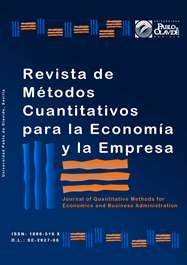Intervalos de pronóstico para los tipos de cambio US/EURO
DOI:
https://doi.org/10.46661/revmetodoscuanteconempresa.2696Palabras clave:
forecast intervals, exchange rate, VAR model, Bayesian VAR model, intervalos de pron\'ostico, tipos de cambio, modelo VAR, modelo VAR bayesianoResumen
El objetivo principal de esta investigación es construir y evaluar intervalos mensuales previstos para los tipos de cambio US/EURO. Las previsiones puntuales usadas para construir los intervalos se basan en un modelo de vectores autorregresivos (VAR) y en un modelo VAR bayesiano para los datos a partir del primer mes de 1999. El pronóstico se basa en el error de intervalos de predicción del mes anterior. Todas las predicciones de intervalos basadas en el modelo VAR incluyen los valores reales de 2014. La probabilidad de que los intervalos basados en el modelo BVAR incluyan los valores registrados de los tipos de cambio es inferior a 0,8, según las pruebas de coeficiente de chi-cuadrado y de verosimilitud.
Descargas
Citas
Aye, G.C.; Balcilar, M.; Bosch, A.; Gupta, R. and Stofberg, F. (2013): The out-of-sample forecasting of non-linear models of real exchange rate behaviour: the case of the South African rand. Department of Economics Working Papers, University of Pretoria, 2013-04.
Boero, G. and Marrocu, E. (2004): "The performance of SETAR models: a regime conditional evaluation of point, interval and density forecasts". International Journal of Forecasting, 20(2), pp. 305-320.
Cai, C.X. and Zhang, Q. (2016): “High-Frequency Exchange Rate Forecasting. European Financial Management. 22(1), pp. 120-141.
Ca'Zorzi, M.; Kocięcki, A. & Rubaszek, M. (2015): “Bayesian forecasting of real exchange rates with a Dornbusch prior”. Economic Modelling, 46, pp. 53-60.
Christoffersen, P.F. (1998): “Evaluating Interval Forecasts”. International Economic Review, 39(4), pp. 841-62.
Fattouh, B.; Mouratidis, K. and Harris, L. (2008): South Africa’s real exchange rate and commodities boom: A Markov regime switching approach, CSAE Conference, Economic Development in Africa.
Giacomini, R. and White, H. (2006): “Tests of conditional predictive ability”. Econometrica, 74, pp. 1545-1578.
Kilian, L. and Taylor, M. (2003): “Why is it so difficult to beat the random walk forecast of exchange rate”. Journal of International Economics, 60, pp. 85-107.
Lam, L.; Fung, L. and Yu, I. (2008): Comparing forecast performance of exchange rate models. Working Paper Hong Kong Monetary Authority, 08/2008.
Lee, Y.S. and Scholtes, S. (2014): “Empirical prediction intervals revisited”. International Journal of Forecasting, 30(2), pp. 217-234.
Meese, R. and Rogoff, K. (1983): “Empirical Exchange Rate Models of the Seventies”. Journal of International Economics, 14, pp. 3-24.
Molodtsova, T. and Papell, D.H. (2009): “Out-of-sample exchange rate predictability with Taylor rule fundamentals”. Journal of International Economics, 77(2), pp. 167-180.
Mtonga, E. (2006): “The real exchange rate of the rand and competitiveness of South Africa’s trade”. MPRA paper 1192.
Olave, P. and Miguel, J.A. (2012): “Bootstrap method in exchange rate forecasting”. University of Zaragoza, Spain.
Stuart, A.; Ord, J.K. and Arnold, S. (1999): Kendall’s Advanced Theory of Statistics, 6th ed., vol. 2A. London: Edward Arnold.
Wallis, K. (2003): “Chi-squared tests of interval and density forecasts, and the Bank of England’s fan charts”. International Journal of Forecasting, 19, pp. 165-175.
Wright, J.H. (2008): “Bayesian model averaging and exchange rate forecasts”. Journal of Econometrics, 146(2), pp.329-341.
Descargas
Publicado
Cómo citar
Número
Sección
Licencia
Derechos de autor 2017 Revista de Métodos Cuantitativos para la Economía y la Empresa

Esta obra está bajo una licencia internacional Creative Commons Atribución-CompartirIgual 4.0.
El envío de un manuscrito a la Revista supone que el trabajo no ha sido publicado anteriormente (excepto en la forma de un abstract o como parte de una tesis), que no está bajo consideración para su publicación en ninguna otra revista o editorial y que, en caso de aceptación, los autores están conforme con la transferencia automática del copyright a la Revista para su publicación y difusión. Los autores retendrán los derechos de autor para usar y compartir su artículo con un uso personal, institucional o con fines docentes; igualmente retiene los derechos de patente, de marca registrada (en caso de que sean aplicables) o derechos morales de autor (incluyendo los datos de investigación).
Los artículos publicados en la Revista están sujetos a la licencia Creative Commons CC-BY-SA de tipo Reconocimiento-CompartirIgual. Se permite el uso comercial de la obra, reconociendo su autoría, y de las posibles obras derivadas, la distribución de las cuales se debe hacer con una licencia igual a la que regula la obra original.
Hasta el volumen 21 se ha estado empleando la versión de licencia CC-BY-SA 3.0 ES y se ha comenzado a usar la versión CC-BY-SA 4.0 desde el volumen 22.










